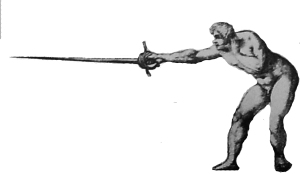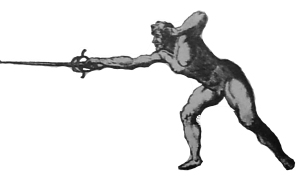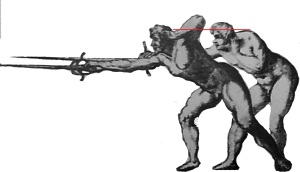Arts & Sciences Research Paper #3. A Small Comparison of the Rapier Styles of Ridolfo Capo Ferro and Salvator Fabris
Our third A&S Research Paper comes to us from Master Donovan Shinnock, of the Shire of Quintavia, and is drawn from his study of the historical masters of rapier fighting. (Prospective future contributors, please check out our original Call for Papers.)
A Small Comparison of the Rapier Styles of Ridolfo Capo Ferro and Salvator Fabris

Salvator Fabris and Ridolfo Capo Ferro are two of the most recognizable names in Italian rapier. Fabris’ manual, “Lo Schermo, overo Scienza d’Arme” (“On Fencing, or Knowledge of Arms”) was printed in 1606, sponsored by the King of Denmark. Capo Ferro’s manual, “Gran Simulacro dell’Arte e dell’Uso della Scherma” (“Great Representation of the Art and Use of Fencing”) was published in 1610, in Siena, Tuscany. While Fabris and Capo Ferro both drew on the same basic underpinnings of Italian rapier theory and applied them to the same ends, the application of these principles looks very different. However, despite these visual and mechanical differences, the end results are similar. But even with the similarity of the end results, some interesting differences between the two masters can be found.
We can begin with examining examples of a basic guard stance from each master. Below is a guard from Capo Ferro.

This is what most people think of as a “standard” guard when using a rapier. It is upright with a firm stance, centered weight, and is well balanced. Looking deeper, we can note the backward lean of the torso and the weight shifting slightly backward in the legs. This allows the fighter to refuse a portion of the body in this case, the chest and head as reasonable opening targets for the opponent’s sword.
Below is an example of a guard from Fabris.

While at first glance this guard could not be more different than the one used by Capo Ferro, the core principles are the same. Bending at the hips rather than the back allows for smooth movement. The fighter’s weight is over the feet. Portions of the body are refused as initial targets, though Fabris prefers the lower torso rather than the upper torso.
Refusing areas of the body as initial targets is key to a successful guard; it can dramatically reduce the area that a fighter needs to cover with the weapon, making defense early in the bout much easier to do effectively. This is an important part of both masters’ theories on rapier, which is to say that you should always assure yourself of safety before you worry about attacking your opponent. Consider the overlapping images below:


In these images you can see how each fighter protects a portion of the body by placing it too far back for an initial attack to reasonably reach. While Capo Ferro and Fabris may have different thoughts on how best to accomplish this, and what other benefits may be gained by their stances, the core concept is the same.
At this point in our process, we can begin to see the differences that each master’s posture brings to the fight. Despite the core concepts being identical, the different body postures have their own advantages and disadvantages which will become obvious. Compare each master’s lunge:


Each fighter has fully extended their his arm, leaned his body forward, and taken a step towards his opponent with his right foot. Each fighter has moved his left arm to better facilitate completely profiling the shoulders to reduce available target area for the opponent to strike. Capo Ferro flings the left arm back, whereas Fabris rotates the elbow upwards. While each will accomplish the same primary goal that of bringing the body into profile Fabris’ method leaves the left hand by the face for emergencies, as well as making for a somewhat easier and faster recovery (as the elbow simply needs to be dropped), whereas Capo Ferro’s left arm must be brought from behind the body all the way to the front. That said, flinging the arm behind the body is a much more instinctive motion, and easier to use effectively.
Other key differences appear in the lunges. Below is an image which has Capo Ferro’s guard and lunge overlaid on each other for clarity:

You can see how when a lunge is performed from Capo Ferro’s guard, there is a loss of height, as indicated by the red lines. In sinking his legs into the lunge as well as moving the torso from leaning somewhat back to leaning deeply into the lunge, the fighter is a fair bit lower to the ground at the end of the lunge. This will cause a loss of power in the attack, as the motion is not driven purely in the direction of the opponent. Additionally, note the forearm and the bends in the joints. The wrist especially is not a particularly strong joint and bending it reduces the strength of the attack.
Compare this to Fabris’ guard and lunge.

There is no loss of height when the lunge is performed from Fabris’ guard. This is primarily due to the forwardleaning portion of the posture; in effect, Fabris is almost “prelunging,” which allows more of the force generated from the lunge to be directed into the opponent. This is also seen in the position of the right arm; there is no elbow or wrist bend in evidence, making a stronger foundation for the sword.
Both Capo Ferro and Fabris use the same core concepts of all Italian rapier the four Agrippan guards, defense before attack, measure, tempo, thrusting over cutting, et cetera. Each respective implementation of these concepts allows all of them to be used to the fullest, but the differences in how each master chooses to utilize them bring about important results. Capo Ferro is much more traditional in stance and concept. His learning curve can be much easier because of this, and the stance could even be applied more readily to other weapons or combat styles. While Fabris has a much steeper learning curve due to the postures he prefers, he has also heavily optimised how he fights to specifically use a rapier against opponents also using rapiers. He has, in effect, specialized his application of Italian rapier in a way that Capo Ferro has not. This does not in any way mean that he is necessarily better than Capo Ferro, but that for this specific application of combat, in many ways he is more efficient, with the more difficult postures allowing for smaller and tighter movements.
Credits
I must thank Lilias de Cheryngton for her assistance in preparing the illustrations for this paper.
Bibliography
Figures 2 and 6, and the images used to create Figure 8 were taken and modified from: Leoni, Tom. Art of Dueling. Highland Village, TX: Chivalry Bookshelf. 2005. Images used by kind permission of Freelance Academy Press; this particular book is out of print but FAP plans to reissue it in 2016.
Figures 1 and 5, and the images used to create Figure 7 were taken and modified from: Leoni, Tom. Ridolfo Capoferro’s The Art and Practice of Fencing. Wheaton, IL: Freelance Academy Press. 2011. Images used by kind permission of Freelance Academy Press; the book may be purchased here.
Figures 3 and 4 were created by using images from each book cited above.
